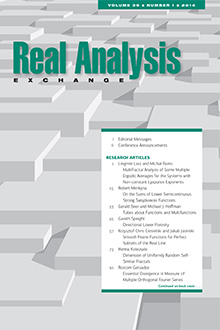Abstract
In \cite[Thm 2.5]{CL:Unif} and \cite[Thm 2]{CL:Unif2} it was proved that there is no uniformly antisymmetric function with two- and three-element range by showing that \(K_3\) and \(K_4\) can be embedded into a graph \(G(h)\) (defined below) for all appropriate \(h\). In this note we will answer Problem 1 from \cite{CL:Unif2} by showing that under the continuum hypothesis there exists \(h\) for which \(K_5\) cannot be embedded into \(G(h)\). In particular, the technique used in the proof that there is no uniformly antisymmetric function with three-element range cannot be used for the four-element range proof. Whether there exists a uniformly antisymmetric function with a finite range remains an open problem. The notion of a uniformly anti-Schwartz function is also defined, and it is proved that there exists a uniformly anti-Schwartz function \(f\colon\mathbb{R}\to\mathbb{N}\).
Citation
Krzysztof Ciesielski. "Uniformly antisymmetric functions and K5." Real Anal. Exchange 21 (1) 147 - 153, 1995/1996.
Information





